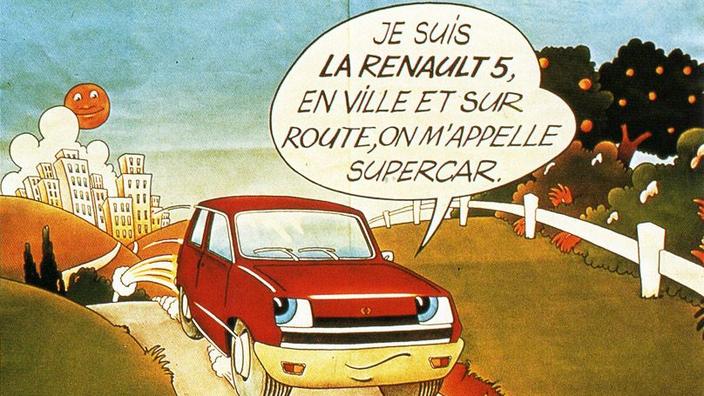Is Renault a visionary?
When in the first days of 1972, the Régie Renault unveiled the R5, no one still suspected that the glorious Thirty were living their last months.
The first oil shock of 1973 sounded the death knell for the period of prosperity.
It results from OPEC's decision to disproportionately increase the price of crude oil sold by the six Persian Gulf countries, in the context of the Yom Kippur War.
It upsets all the cards in the automotive sector.
The economic crisis is causing panic in the ranks of this industry.
Pierre Dreyfus, the president of Régie Renault, is not unhappy to be able to rely on the R5 to face this crisis.
An economical car, the new darling of the House of Billancourt is a strange animal.
This city car is part of the pop wave with its daring colors (orange, yellow and apple green), its plastic shields and its black leatherette dashboard.
The banquettes stretched with orange vinyl finish painting the portrait of a decidedly uninhibited city dweller.
Its silhouette is really modern.
If it is, like its rivals, the Mini and the Fiat 127, a two-door hatchback, 4-seater water-cooled 4-cylinder engine, the similarities end there.
The mechanics that come from the R4 are arranged longitudinally behind the axis of the front wheels.
The transmission is placed in front of the engine, so that the latter had to be housed in an overflowing recess inside the passenger compartment.
A choice dictated mainly by the bias of compactness.
The R5 does not exceed 3.50 meters.
Its heir, the Clio V, now measures 4.05 m.
The arrangement adopted by R5 also allowed considerable savings.
The structure of the R5 closely resembles that of the R6.
Renault
The platform, engine mounts and suspensions are very similar.
However, it differs from it by the platform solution welded to the bodywork.
The mechanics come from the R4: 782 cm3 of 36 hp for the R5 L, 956 cm3 of 47 hp for the R5 TL.
At the end of 1972, the smart and versatile R5 found the Peugeot 104 on its road. More sober, the Sochalian city car put forward its more versatile 5-door body.
Arrived at the right time as a response to the crisis, the R5 will evolve with the vintages and be enriched with new versions.
In the spring of 1976, Renault launched in small series a sports version called Alpine.
Produced in Dieppe, it can be recognized by its wider wheels and tires, its black shield incorporating spoiler and fog lights, its lowered frame and decorative patterns.
The R5 Alpine is based on a 1397cc 4-cylinder engine with hemispherical chamber cylinder head, 10: 1 compression ratio and twin barrel carburetor.
It delivers the power of 93 horsepower at 6,400 rpm.
It is associated with a five-speed gearbox from the R16 TX.
The top speed exceeds 170 km / h.
The R5 Alpine served as the basis for the Renault-Elf Gordini Cup organized from 1977.
Renault
In 1978, Renault made an impression by presenting a model of an impressive R5 Turbo at the Paris Motor Show.
Passed through the hands of Bertone designers, the R5 is transfigured.
It is no longer a question of traction but of propulsion thanks to the installation of the engine in the rear central position.
The 1,397 cm3 now delivers nearly 200 horsepower.
Playing the role of the locomotive of the range at a time when Renault imposed its F1 turbocharged single-seaters in the grand prix, the R5 Turbo was presented in its final version in 1978. Equipped with a Garret T3 turbo “blowing” at 0, 9 bar at 2,900 rpm and Bosch K-Jetronic injection, the 4-cylinder of the R5 Alpine develops 160 horsepower at 6,000 rpm.
Transmission to the rear wheels is provided by a double-disc clutch and a 5-speed gearbox derived from that of the R30 TX.
The R5 Turbo is of course longer than a normal R5 (3.66 m) and wider: 1.75 m, or 23 cm more.
Weighing 970 kilos, it is capable of exceeding 200 km / h and covering the kilometer from a standing start in less than 28 seconds.
Billed over 100,000 francs, the ball of nerves is not within reach of all budgets.
The following year, to stem the craze for the VW Golf GTi, Renault gave the R5 Alpine a boost by installing ... a turbo.
The 1,397cc 4-cylinder now delivers 110 hp.
The front axle carried by 13-inch wheels has difficulty digesting the influx of torque, especially on wet roads.
In 1984, Renault, which had just missed the F1 title by a hair with Alain Prost, replaced the R5 with the Supercinq.
It was about time, because Peugeot has dominated the market since 1983 with the 205. More modern in line, more livable, the Supercinq is satisfied, at its launch, with proven engines.
In 1985, the new city car joined the GTI club with the GT Turbo.
Specific shields and rims accompany this new version of which the 1,400 cm3 carburettor produces 115 hp.
Equipped with a new rear axle, the GT Turbo reaches 200 km / h.
Meanwhile, the success of the R5 Turbo in rally events is reflected in the R5 lineup.
The Renault Supercinq.
Renault
In 1990, Renault decided that it was time for the R5 to bow out and make way for the Clio.
The new diamond city car inaugurates the era of names.
Bigger than the R5, it responds to new style trends.
During 2019, the French manufacturer launched the fifth generation.

